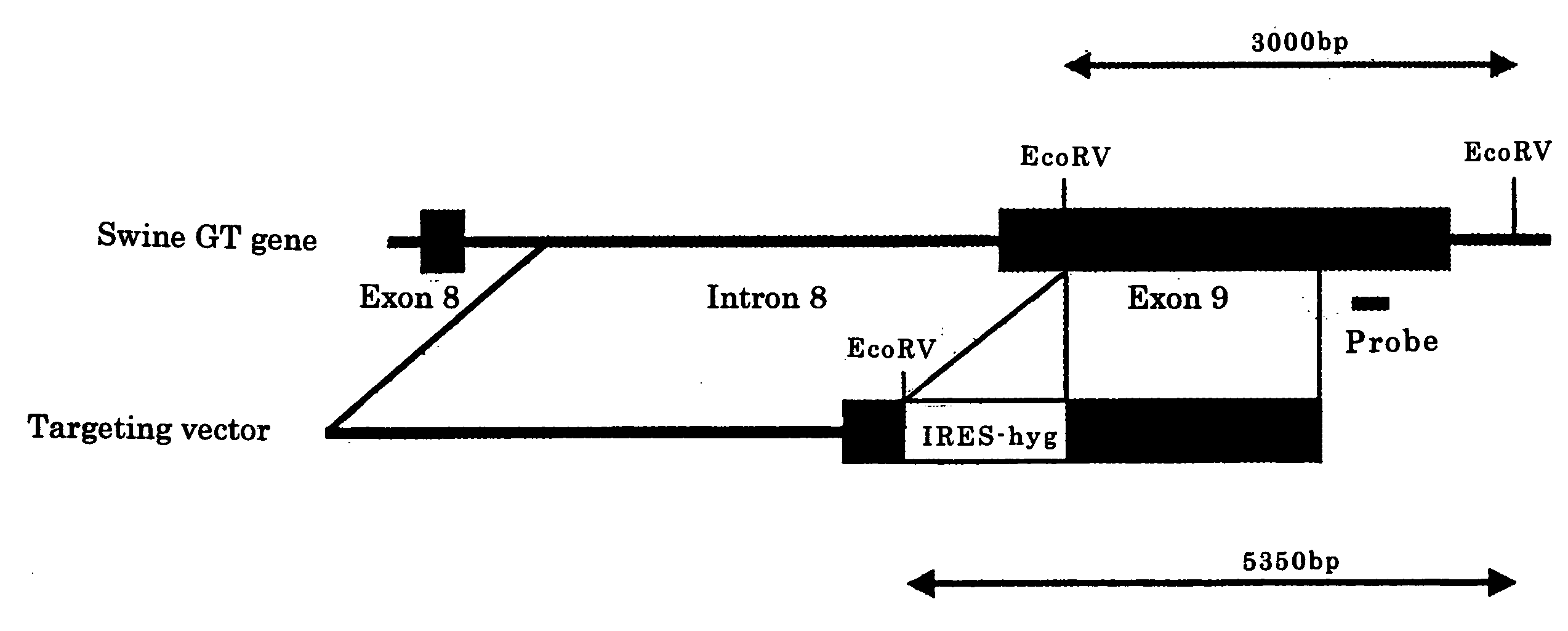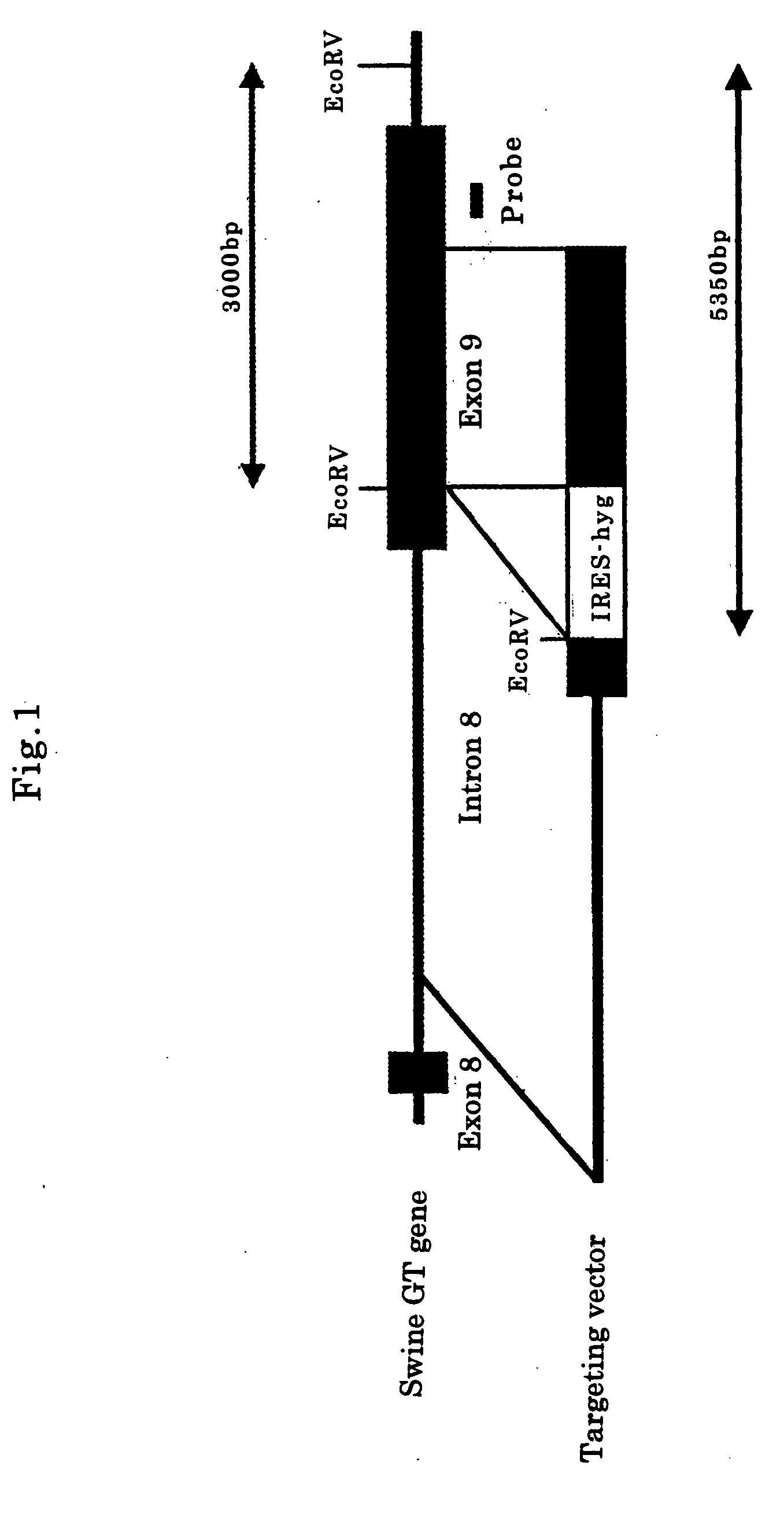Swine Cell For Xenotransplantation, Method of Selecting the Same and Swine For Xenotransplantation
a swine cell and xenotransplantation technology, applied in the field of swine cell for xenotransplantation, method of selecting same, swine for xenotransplantation, can solve the problems of inefficiency, inability to apply the complement selection method directly, and inability to overcome the acute rejection characteristic of xenotransplantation
- Summary
- Abstract
- Description
- Claims
- Application Information
AI Technical Summary
Problems solved by technology
Method used
Image
Examples
example 1
Swine Cells Expressing Human Complement Inhibitor and / or Human N-Acetyl Glucosaminyl Transferase III (GnT-III)
[0106]Transgenic swine (Transplant. Proc. 2003: 35; 516-7) expressing human complement inhibitor and human GnT-III in local cells causing hyperacute rejection, and ordinary swine were mated, and fetus was collected on day 28 to 33 of gestation, and sectioned, treated in 0.25% trypsin-0.02% EDTA (Gibco BRL) for 30 minutes at 37° C., and cultivated in 10% bovine fetal serum added DMEM culture medium (Gibco BRL) at 37° C. and 5% CO2, and cells having DNA of human DAF and human GnT-III and having a normal karyotype were selected.
[0107]Similarly, a transgenic swine (Mol. Reprod. Del. 2002:61;302-11) expressing human DAF at local cell where hyperacute rejection occurs is mated with an ordinary swine, and cells having human DAF and having a normal karyotype were selected.
[0108]The cells were confirmed to have DNA of human DAF or human GnT-III by the method described below, and to h...
example 2
Single GTKO Swine Cell Expressing Human Complement Inhibitor and / or Human GnT-III
[0109]In the above swine cells (2×106 cells), the targeting vector for GTKO (10 μg, FIG. 1) was injected by electroporation (300 V, 975 μFD), and cultivated for 1 to 4 days. Further cultivating for 7 to 14 days in culture medium with hygromycin (50 to 200 μg / ml), colonies were picked up in 20 to 30 days after introduction of the targeting vector, and single GTKO swine cells expressing human DAF and human GnT-III were selected. Similarly, single GTKO swine cells expressing human DAF were selected.
[0110]The swine cells were confirmed to be single GTKO swine cells by the Southern blotting method described below. That is, in the cells of ordinary swine (wild type), only band of 3000 bp was observed, but in the single GTKO swine cells, bands of 3000 bp and 5350 bp were observed (lanes 1 and 2 in FIG. 2). The single GTKO cells were presented for preparation of single GTKO cloned swine embryos.
example 3
[0111]Single GTKO Cloned Swine Embryo Expressing Human Complement Inhibitor and / or Human GnT-III
[0112]From the follicles of swine ovaries sampled at slaughterhouse, swine ovum-cumulus oophorus cell complexes (3 to 6 mm in diameter) were sucked and sampled, and cultivated in culture medium NCSU-23 with 0.6 mM cysteine, 10 ng / ml EGF, 10 IU / ml eCG, 10 IU / ml hCG and swine follicle solution (10% (v / v)) at 38.5° C. and in 5% CO2 for 15 to 26 hours, and further cultivated in culture medium without hormones for 15 to 26 hours. By treating in hyaluronidase (1 mg / ml), the cumulus oophorus cells were removed, and the ova releasing the first polar body were sampled. By 10 mM Hepes buffer Tyrode's lactose culture medium containing 0.3% (w / v) polyvinyl pyrrolidone, 10% (v / v) bovine fetal serum and 7.5 μg / ml cytochalasin B, the cumulus oophorus cells were removed from the swine ova, and immediately by using a pipette (diameter 35 μm), the first polar body and its peripheral cytoplasm (about 10% of...
PUM
 Login to View More
Login to View More Abstract
Description
Claims
Application Information
 Login to View More
Login to View More - R&D
- Intellectual Property
- Life Sciences
- Materials
- Tech Scout
- Unparalleled Data Quality
- Higher Quality Content
- 60% Fewer Hallucinations
Browse by: Latest US Patents, China's latest patents, Technical Efficacy Thesaurus, Application Domain, Technology Topic, Popular Technical Reports.
© 2025 PatSnap. All rights reserved.Legal|Privacy policy|Modern Slavery Act Transparency Statement|Sitemap|About US| Contact US: help@patsnap.com



